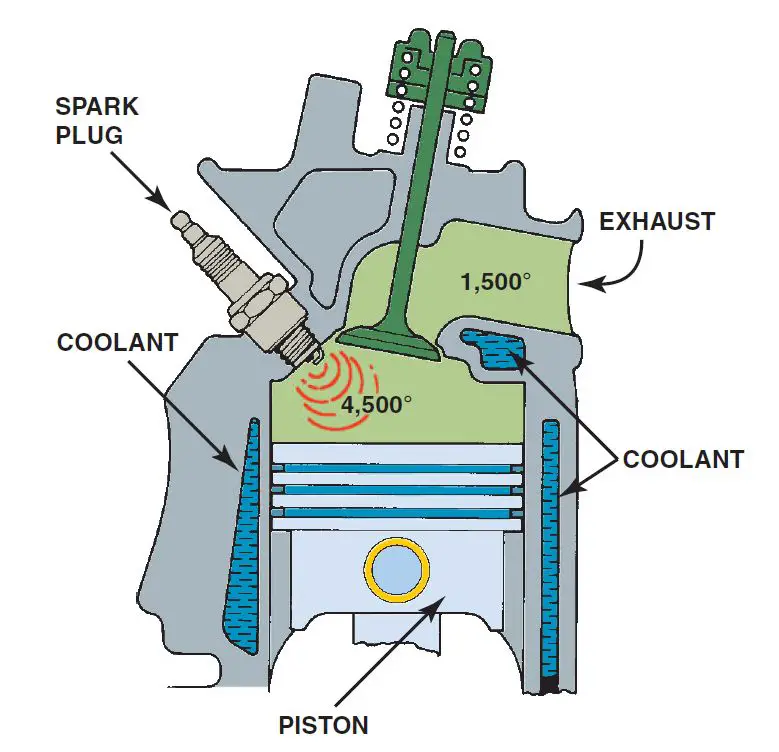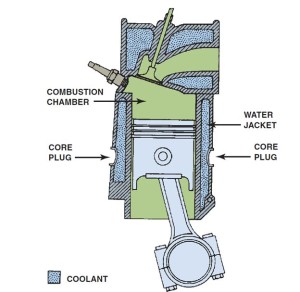Cooling System
Purpose and Function
Satisfactory cooling system operation depends on the design and operating conditions of the system. The design is based on heat output of the engine, radiator size, type of coolant, size of water pump (coolant pump), type of fan, thermostat, and system pressure. The cooling system must allow the engine to warm up to the required operating temperature as rapidly as possible and then maintain that temperature.
Peak combustion temperatures in the engine run from 4,000°F to 6,000°F (2,200°C to 3,300°C). The combustion temperatures will average between 1,200°F and 1,700°F (650°C and 925°C). Continued temperatures as high as this would weaken engine parts, so heat must be removed from the engine. The cooling system keeps the head and cylinder walls at a temperature that is within the range for maximum efficiency. The cooling system removes about one-third of the heat created in the engine. Another third escapes to the exhaust system.
Low Temperature Engine Problems
Engine operating temperatures must be above a minimum temperature for proper engine operation. If the coolant temperature does not reach the specified temperature as determined by the thermostat, then the following engine-related faults can occur.
- A P0128 diagnostic trouble code (DTC) can be set. This code indicates “coolant temperature below thermostat regulating temperature,” which is usually caused by a defective thermostat staying open or partially open.
- Moisture created during the combustion process can condense and flow into the oil. For each gallon of fuel used, moisture equal to a gallon of water is produced. The condensed moisture combines with unburned hydrocarbons and additives to form carbonic acid, sulfuric acid, nitric acid, hydrobromic acid, and hydrochloric acid.
To reduce cold engine problems and to help start engines in cold climates, most manufacturers offer block heaters as an option. These block heaters are plugged into household current (110 volts AC) and the heating element warms the coolant.
High Temperature Engine Problems
Maximum temperature limits are required to protect the engine. Higher than normal temperatures can cause the following engine-related issues.
- High temperatures will oxidize the engine oil producing hard carbon and varnish. The varnish will cause the hydraulic valve lifter plungers to stick. Higher than normal temperatures will also cause the oil to become thinner (lower viscosity than normal). Thinned oil will also get into the combustion chamber by going past the piston rings and through valve guides to cause excessive oil consumption.
- The combustion process is very sensitive to temperature. High coolant temperatures raise the combustion temperatures to a point that may cause detonation (also called spark knock or ping) to occur.
Cooling System Operation
Purpose and Function
Coolant flows through the engine, where it picks up heat. It then flows to the radiator, where the heat is given up to the outside air. The coolant continually recirculates through the cooling system, as illustrated in
Cooling System Operation
The temperature of the coolant rises as much as 15°F (8°C) as it goes through the engine and cools as it goes through the radiator. The coolant flow rate may be as high as 1 gallon (4 liters) per minute for each horsepower the engine produces.
Hot coolant comes out of the thermostat housing on the top of the engine on most engines. The engine coolant outlet is connected to the radiator by the upper radiator hose and clamps. The coolant in the radiator is cooled by air flowing through the radiator. As the coolant moves through the radiator, it cools. The cooler coolant leaves the radiator through an outlet and the lower radiator hose, and then flows to the inlet side of the water pump, where it is recirculated through the engine.
- NOTE: Some newer engine designs such as Chrysler’s 4.7 liter V-8 and General Motor’s 4.8, 5.3, 5.7, and 6.0 liter V-8s place the thermostat on the inlet side of the water pump. As the cooled coolant hits the thermostat, the thermostat closes until the coolant temperature again causes it to open. Placing the thermostat in the inlet side of the water pump therefore reduces the rapid temperature changes that could cause stress in the engine, especially if aluminum heads are used with a cast iron block.
Radiators are designed for the maximum rate of heat transfer using minimum space. Cooling airflow through the radiator is aided by a belt- or electric motor–driven cooling fan.
Next Steps towards ASE Certification
Now that you’re familiar with Cooling System Operation and Diagnosis, try out our free Automotive Service Excellence Tests to see how much you know!
![ASE Certification Training HQ - Free ASE Practice Tests [Updated 2021]](https://asecertificationtraining.com/wp-content/themes/simplefolio/images/ASE Certification Logo.png)


